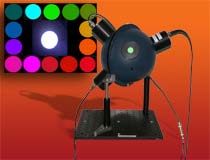Portable ’rainbow’ source improves color calibrations

NIST’s new portable "rainbow" source for calibrating color measurement instruments. In the background are a sampling of colors generated with the source.
If you need bright blue light at a very specific wavelength, the National Institute of Standards and Technology (NIST) can make it—and fast.
In the world of color, this is no small accomplishment. NIST’s traditional light sources, such as incandescent lamps, are thermal. A blue thermal source would need to function at such a high temperature that components would melt. Lack of blue light sources introduces uncertainty when calibrating instruments that measure the color of things like bright stars or the open ocean. Knowing the exact color is important because it allows scientists, for example, to use remote satellites to judge the concentration of plant life in the ocean, which in turn affects global climate.
Now NIST has developed a “rainbow source” that can be tuned across the entire visible light spectrum, from red to blue light. This unique source exploits recent materials advances in light-emitting diodes (LEDs) of different colors. By mixing exact percentages of LEDs at different wavelengths of visible light with the desired brightness, the optical properties of the source (such as the color) can be changed and tailored for a particular application. The source uses commercial LEDs. NIST researchers characterized them and developed the packaging, electronics and software. In addition, the tunable light source is highly portable: It is a sphere about 30 cm (1 foot) in diameter and weighs about two kilograms (5 pounds). Battery operated versions have been developed for field applications.
NIST researchers described the invention at the Ocean Color Research Team Meeting in Washington, D.C. on April 14. The National Oceanic and Atmospheric Administration has ordered a simplified version of the rainbow source to reduce uncertainties in calibrations of a satellite that measures ocean color, as part of a program that monitors the carbon balance between the ocean and atmosphere. The source also could simplify color calibrations in industrial and other research applications.
Additional details will be presented at a meeting at NIST in Gaithersburg, Md., on May 10-14 sponsored by NIST, the InterSociety Color Council, and the Council for Optical Radiation Measurements.
Media Contact
More Information:
http://www.nist.gov/All latest news from the category: Power and Electrical Engineering
This topic covers issues related to energy generation, conversion, transportation and consumption and how the industry is addressing the challenge of energy efficiency in general.
innovations-report provides in-depth and informative reports and articles on subjects ranging from wind energy, fuel cell technology, solar energy, geothermal energy, petroleum, gas, nuclear engineering, alternative energy and energy efficiency to fusion, hydrogen and superconductor technologies.
Newest articles

First-of-its-kind study uses remote sensing to monitor plastic debris in rivers and lakes
Remote sensing creates a cost-effective solution to monitoring plastic pollution. A first-of-its-kind study from researchers at the University of Minnesota Twin Cities shows how remote sensing can help monitor and…

Laser-based artificial neuron mimics nerve cell functions at lightning speed
With a processing speed a billion times faster than nature, chip-based laser neuron could help advance AI tasks such as pattern recognition and sequence prediction. Researchers have developed a laser-based…

Optimising the processing of plastic waste
Just one look in the yellow bin reveals a colourful jumble of different types of plastic. However, the purer and more uniform plastic waste is, the easier it is to…



